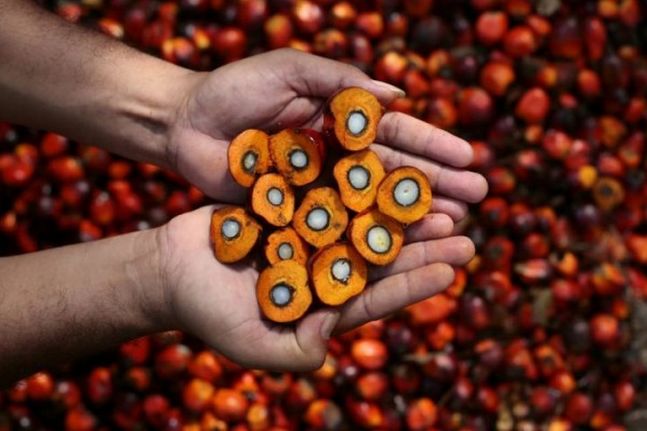ALL PALM OIL
Supplements for cardiovascular fitness

ORIGINS
Palm oil and palm kernel oil (also called the oil palm seed) are two kinds of vegetable oils derived from palm oil, mainly from Elaeis guineensis. The Elaeis guineensis, despite being native to Africa, is now cultivated mainly in Malaysia and Indonesia.
From palm oil are obtained, then, palm oil (from the fruit) and palm kernel oil (from its seeds): both are solid or semi-solid at room temperature, but with a fractionation process can be separated into component liquid and solid.
Palm oil is the second most edible oil product, after soybean oil. It is also an important component in the production of many soaps and products for the care of the person.
HISTORY
Palm oil has always been used in West African countries as cooking oil. The European merchants who traded in those places sometimes imported it in Europe, but because the oil was plentiful and cheap, palm oil remained rare outside West Africa. Palm oil later became a highly traded by British merchants to its use as a lubricant for the machines of the Industrial Revolution, and as raw material for products of soap. Oil palm was introduced in 1848 by the Dutch island of Java and in 1910 in Malaysia by Scottish and English. Since the sixties the government promoted a great plan of cultivation of oil palm in order to fight poverty. Each settler was allocated about 4 hectares of land to be cultivated with oil palm or rubber, and 20 years to repay the debt
WHY 'TO USE
In most of the recipes of bakery products it is necessary to add a certain amount of fatty substances: oil, butter, depending on the preparation. The fats that provide a better structure and texture to the baked product are saturated fats, those semi-solid like butter, not vegetable oils, which are unsaturated and liquids.
Palm oil, while being of plant origin, is an exception, since it has a fatty acid composition more similar to butter: is in fact essentially composed of saturated fatty (palmitic, stearic and lauric). Consequently it lends itself well, for its chemical properties, to replace butter in industrial preparations.
Compared to butter, palm oil has a much lower cost, is virtually tasteless, and added to formulas does not affect its attractiveness. Furthermore, compared to butter it ensures long shelf greater of the products, for its greater resistance to temperature and to rancidity.
Its massive entry of our food came as a result to tightening up the standards of the World Health Organization on hydrogenated fats, such as margarine, a transformation of vegetable oils first employed as a fallback butter, but now deemed harmful on several fronts health. If now we are left to consume palm oil, therefore, it is also to avoid in our food there was worse. With the entry into force of Reg.Ue 1169/2011, 2015 it is mandatory to indicate on the labels of food products in the European Community, the specific vegetable origin oils and fats and therefore also declare the use of oil palm.
WHERE AND 'THIS
There are many occasions in a day when we can take palm oil. It comes in fact in many baked goods like cereals, cookies, packaged snacks. Besides breakfast we can meet even in baked salty crackers (crackers, snacks, bread ...), but also in packaged ice cream. It 'also in many baby foods (biscuits, powdered milk in particular)
HEALTH RISKS
It hurts? It depends on how much we consume. Since this is a saturated fat, it should be treated exactly like any other saturated fats (butter, lard, etc.). So it is good to limit consumption. But what is wrong is to argue that other fats, such as butter, margarine or other vegetable oils, especially when cooked, not hurt, while palm oil yes. The acceptable threshold of consumption is that of the 10% maximum of total daily calories. A share but comprises all saturated fats, both those of plant or animal origin, not only those of palm oil.
If consumed occasionally palm oil is not a particular problem for people's health. Things change when it is taken every day, several times a day. In this case the risks are mainly dependent on the cardiovascular system. This is because one of the most harmful saturated fats is to promote high levels of triglycerides and LDL ("good cholesterol") and low levels of HDL ("bad cholesterol"). Risk common to all saturated fats.
Against palm oil does not have at present official positions by the World Health Organization, the European Food Safety Authority, the Ministry of Health or Institute of Health: bodies involved in monitoring the our health, but several studies are underway.
THE QUESTION SOCIAL / ENVIRONMENTAL
The social controversy linked oil shovel about fear is that the removal of land for the cultivation of oil palm may have damaged the resident populations.
The issue concerns the environmental damage caused by deforestation for the establishment of crops, which will endanger species already endangered, such as play dough or the Sumatran tiger.
Supplements for cardiovascular fitness
